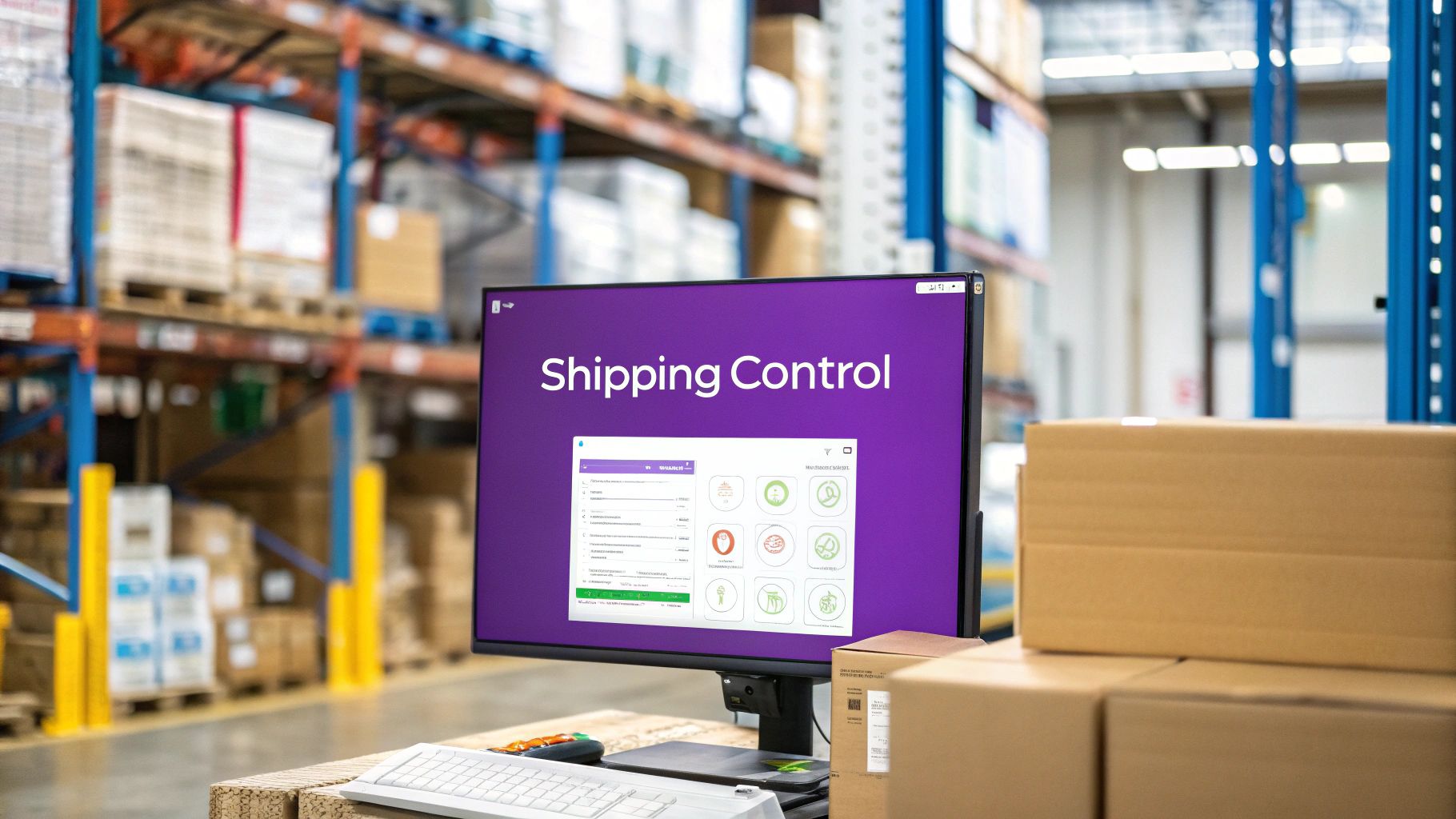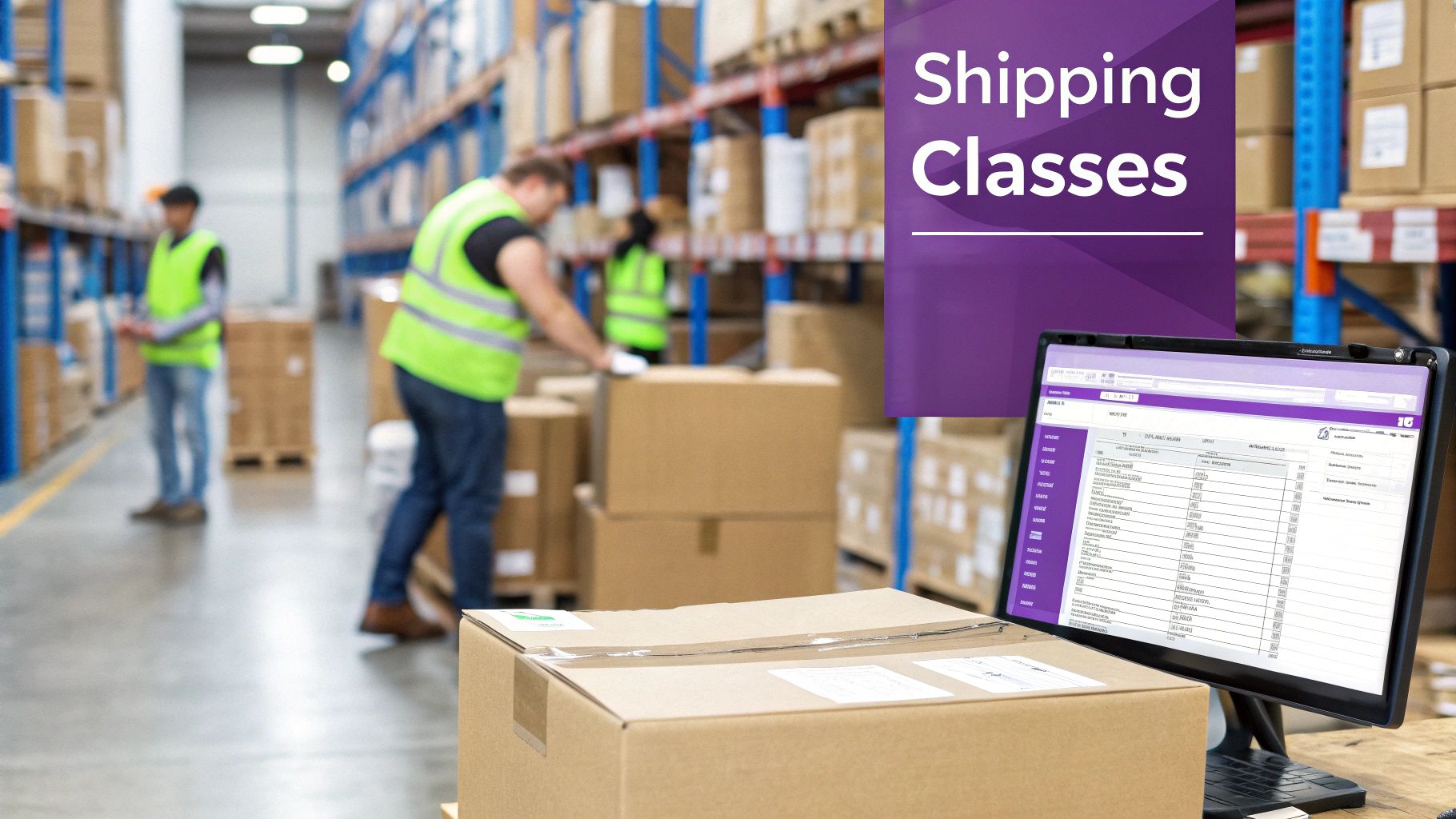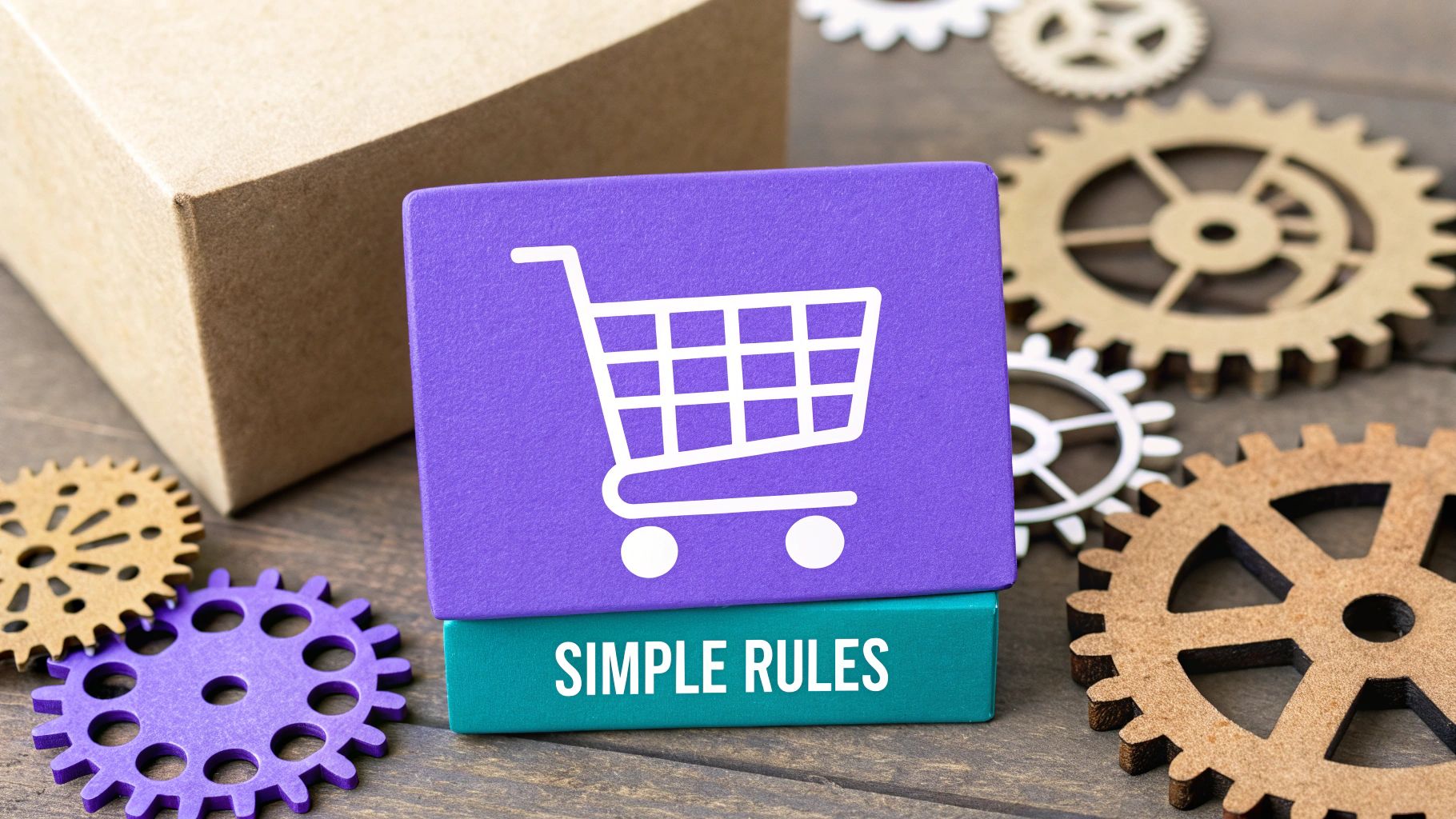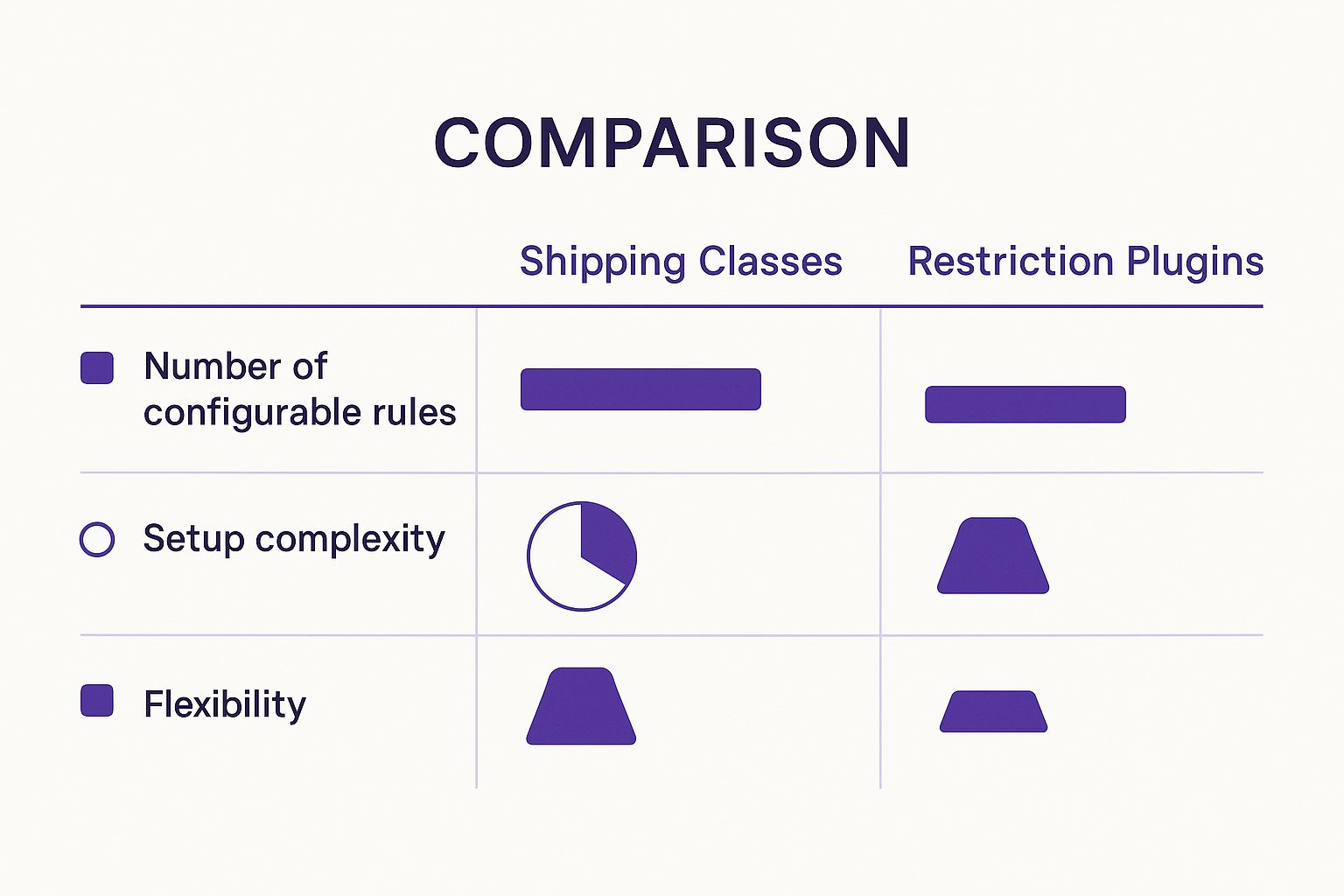
WooCommerce Shipping Classes vs Restriction Plugins: When You Need More
Discover when to choose WooCommerce Shipping Classes vs Restriction Plugins for better control. Learn which solution fits your shipping needs today.
Cody Y.
Updated on Oct 1, 2025
Let's get one thing straight from the jump: WooCommerce Shipping Classes are for grouping similar products to apply different rates. Think 'bulky' vs. 'standard' items. In contrast, Restriction Plugins are for creating complex rules that control which shipping options your customers even see at checkout.
Your choice boils down to a simple question: do you need to adjust shipping costs or enforce logistical rules?
Navigating Complex WooCommerce Shipping Rules

If you're running a WooCommerce store, you already know shipping is rarely a one-size-fits-all game. The simple flat-rate or free shipping options that worked when you first launched can quickly become a drain on your profits as your product line and customer base grow.
Unexpectedly high shipping costs can scare off nearly half of your potential customers, making this a critical area to get right. This guide will cut through the noise, showing you how to tell when it's time to graduate from WooCommerce's built-in tools to a more powerful, customized shipping solution.
Core Differences at a Glance
The first step is understanding what each tool is actually built for. Shipping Classes are a native feature designed for cost calculation. Restriction plugins, on the other hand, are an entirely separate layer of logic that dictates method availability.
| Capability | WooCommerce Shipping Classes | Shipping Restriction Plugins |
|---|---|---|
| Primary Goal | To calculate different shipping rates for groups of products. | To show or hide shipping methods based on conditional rules. |
| Complexity | Basic; groups products to apply varied costs. | Advanced; creates complex logic based on multiple conditions. |
| Core Function | Rate adjustment (e.g., charge more for heavy items). | Method control (e.g., hide air freight for certain states). |
| Built-in/Plugin | Built-in WooCommerce feature. | Requires a dedicated third-party plugin. |
Why This Distinction Matters
Choosing the right tool has a massive impact on your store's efficiency and the customer's checkout experience. Trying to use shipping classes to solve a restriction problem—like preventing an item from shipping to a specific state—is like using a hammer to turn a screw. It's just the wrong tool for the job and will only lead to messy workarounds and costly mistakes.
Key Insight: Shipping Classes answer the question, "How much should shipping cost for this group of items?" Restriction Plugins answer, "Is this shipping method even allowed for this specific order?"
On the flip side, using a powerful restriction plugin just to add a surcharge for bulky items is total overkill. Knowing the exact moment your store’s needs outgrow the basic rate-setting of shipping classes is key to scaling your business without pulling your hair out. Grappling with these intricate shipping rules directly impacts customer behavior, and there are many strategies to reduce cart abandonment on e-commerce platforms that tie into this. This guide will help you pinpoint that pivotal moment.
Before you can even think about using a restriction plugin, you first need to get a handle on the most fundamental shipping tool built right into WooCommerce: shipping classes.
Think of shipping classes as simple, organizational tags for your products. Their only job is to group similar items together so you can apply different shipping rates to them. This is your first step away from a one-size-fits-all flat rate.
For example, you might sell small art prints and massive framed canvases. While they're both "art," shipping them costs wildly different amounts. You'd create classes like 'Bulky' or 'Fragile,' assign them to the right products, and you're halfway there. It’s this simple grouping that unlocks more accurate shipping prices at checkout.
Creating and Assigning Your First Classes
Getting classes set up is dead simple. Head over to WooCommerce > Settings > Shipping > Shipping classes, and you can start creating groups that make sense for what you sell.
You might want to create classes for:
- Heavy Items: For things like furniture or equipment that cost a fortune to ship.
- Fragile Goods: For products needing special packaging and handling, which adds to your cost.
- Perishable Products: For items that need expedited or even refrigerated shipping.
- Standard: A catch-all class for everything else that's easy to ship.
This screenshot from the official WooCommerce documentation shows you just how clean the interface is for adding and managing these.
Once your classes are ready, you just pop into a product's edit screen, click the 'Shipping' tab, and assign the class. That's the link that tells WooCommerce how to calculate rates later.
Applying Rates in Shipping Zones
Just creating the classes doesn't do anything on its own. The magic happens when you connect them to your shipping methods inside a shipping zone. This is where you actually define the cost for each class.
Let's say you have a 'United States' shipping zone with a Flat Rate method. Inside that method's settings, you can set different costs:
- No Shipping Class Cost: $5.00
- 'Heavy Items' Class Cost: $25.00
- 'Fragile Goods' Class Cost: $10.00
Now, when a customer adds a fragile item to their cart, WooCommerce tacks on the $10.00 fee. If they add a heavy item instead, the $25.00 rate kicks in.
Crucial Takeaway: Shipping classes are all about cost adjustment. They don’t hide or show shipping methods; they only change the price of the methods you already offer. This is the single most important distinction to understand when comparing them to restriction plugins.
This basic flexibility is essential. As your store grows, you can’t survive on a single shipping price. Grouping bulky furniture lets you charge what it actually costs to ship, while keeping rates low and attractive for small accessories. You can learn more about how shipping classes support business profitability on wpdatatables.com. Mastering this foundational tool makes it crystal clear when you’ve hit its limits and truly need the power of a dedicated restriction plugin.
When You Need Granular Shipping Control

While shipping classes are great for adjusting costs, they hit a wall when your business needs to enforce actual shipping rules. This is the exact moment the conversation has to shift from simple rate tweaks to genuine, granular shipping control.
Shipping restriction plugins are the next step up in managing your store’s logistics. They drop in a powerful layer of conditional logic that native WooCommerce just can't touch, turning your shipping setup from a static price list into a dynamic, intelligent system.
Moving Beyond Simple Rate Adjustments
Imagine you sell gourmet chocolates. During the summer, you absolutely cannot risk sending them via standard ground to hot states like Arizona or Florida—they'd arrive as a melted mess. A shipping class can't solve this. It can only make ground shipping more expensive, not block it entirely.
This is where a restriction plugin shines. It lets you create rules that show or hide shipping methods based on specific criteria that go way beyond a product's general category.
Key Takeaway: Restriction plugins don't just change shipping prices; they control shipping availability. They answer the critical question, "For this specific cart, going to this specific location, which shipping methods are actually allowed?"
These plugins give you the power to build a sophisticated, rule-based system. You could, for example, prevent fragile items from shipping to certain regions or disable express options for oversized products. This level of control is flat-out impossible with shipping classes alone.
Real-World Scenarios Demanding a Plugin
The need for a restriction plugin becomes crystal clear when you're facing complex logistical puzzles. They are essential for any store that needs to manage more than just the price tag on a shipping label.
Think about these common business headaches that only a restriction plugin can truly solve:
- Location-Based Rules: Preventing overnight air shipping for perishable goods to remote postal codes where next-day delivery isn't guaranteed.
- Product-Specific Logic: Hiding all shipping options except 'Local Pickup' for oversized or hazardous materials that can't be sent via standard carriers.
- Cart-Based Conditions: Disabling free shipping if a specific low-margin or heavy product is in the cart, even when the subtotal meets the free shipping threshold.
- User Role Exclusivity: Offering exclusive, discounted shipping methods (like 'Wholesale Freight') that are only visible to customers with a 'Wholesale' user role.
These plugins offer a huge array of conditions to build rules from, often including criteria like cart subtotal, item count, product weight, or even specific coupon codes. You can see a detailed list of these powerful conditions by reviewing common restriction types available in advanced plugins.
When your business logic dictates who can receive an item, where it can go, or how it gets there, you've officially outgrown what shipping classes can do. It's a clear sign you need a dedicated restriction plugin to protect your margins, comply with regulations, and give your customers a frustration-free checkout.
Comparing Shipping Classes And Restriction Plugins
To pick the right tool, you have to move beyond simple definitions and put WooCommerce Shipping Classes and Restriction Plugins head-to-head. This isn't about a generic pros and cons list; it's about seeing how each one holds up under real-world business pressure.
The core difference comes down to purpose. Shipping classes are designed to group products to apply different shipping rates. Restriction plugins, on the other hand, are built to enforce shipping rules. One changes the price, the other controls availability.
Rule Granularity
How detailed and specific can you get with your shipping logic? This is probably the single biggest difference between the two.
Shipping classes are a broad-stroke tool. You can create a "Heavy" class, assign it to ten different products, and they all get the same rate adjustment. It’s efficient for simple cost management, but it offers zero nuance. It can't tell the difference between two products in the same class being shipped to different states.
Restriction plugins offer surgical precision. They let you build rules that target individual products, cart contents, specific customer locations, or even user roles. For instance, you could block a single SKU from shipping to one particular ZIP code, or hide an overnight shipping option if the cart's total weight tips over 50 lbs. That level of control is flat-out impossible with shipping classes alone.
This visual breaks down the core differences in complexity, rules, and flexibility.

As you can see, restriction plugins give you far more configurable rules and flexibility, but that power comes with a bit more setup complexity.
Use-Case Complexity
The complexity of your shipping needs will naturally point you to the right solution. Shipping classes are perfect when things are straightforward.
- Simple Use Case (Shipping Classes): A store sells t-shirts and posters. They create a "Poster Tube" class just to add a $2 surcharge to cover the cost of the special packaging. Easy.
- Complex Use Case (Restriction Plugin): A gourmet food shop sells perishable cheese. They have to block standard ground shipping to states with a transit time of over two days, forcing customers in those areas to choose "Refrigerated Express" shipping—but only during the summer months.
The moment your logic involves "if-then" conditions based on anything other than simple product groups, you've outgrown what shipping classes can do. For a deeper dive into the available tools, check out this comparison guide of the best shipping restriction plugins for WooCommerce.
Key Differentiator: Shipping Classes calculate rates for product groups. Restriction Plugins enforce rules on shipping options. One adjusts the price; the other controls what's even possible at checkout.
Implementation Effort And Scalability
How much work is it to set up, and will it grow with your business? These are critical questions. Setting up shipping classes is a native WooCommerce function, so it's incredibly fast. You can create a few classes and assign rates within your shipping zones in minutes. But that simplicity comes at a price: scalability. As your catalog and shipping rules multiply, trying to manage dozens of classes with layered rate tables becomes a messy, error-prone nightmare.
A restriction plugin requires more initial setup—no question. You have to install it, get familiar with the interface, and carefully build out your conditional rules. While this takes more time upfront, the result is a system that's built to scale. A clean set of rules can handle a massive product catalog with complex shipping needs much more reliably than a patchwork of shipping classes ever could.
Let's break down the key differences in a simple table.
Feature Comparison Shipping Classes vs Restriction Plugins
| Feature/Capability | WooCommerce Shipping Classes | Shipping Restriction Plugins |
|---|---|---|
| Primary Function | Adjusts shipping rates based on product groups. | Enforces shipping rules based on conditional logic. |
| Rule Granularity | Low. Applies to broad groups of products. | High. Targets individual products, locations, users, and cart attributes. |
| Best For | Simple cost adjustments (e.g., bulky, fragile items). | Complex logistics (e.g., location restrictions, method hiding). |
| Implementation | Very fast. A built-in WooCommerce feature. | Slower. Requires plugin installation and rule configuration. |
| Scalability | Limited. Becomes messy with complex product lines. | Excellent. Handles growing and intricate rule sets efficiently. |
Ultimately, the choice comes down to whether your store’s biggest challenge is managing shipping costs or controlling shipping logistics. If all you need to do is tweak prices for different types of products, shipping classes will do the job. But the moment you need to dictate how, where, and if a product can be shipped, a restriction plugin stops being a nice-to-have and becomes an essential business tool.
Choosing the Right Solution for Your Store

Knowing the technical difference between WooCommerce Shipping Classes and a dedicated restriction plugin is one thing. Actually choosing the right one for your store? That's what really matters. The best tool depends entirely on your products, your business model, and the real-world shipping headaches you’re trying to solve.
Let’s walk through a few common, practical scenarios. You’ll probably see a bit of your own operation in one of them. It'll quickly become clear whether the simple, built-in shipping classes are enough or if you absolutely need the granular control of a plugin.
Scenario 1: The Clothing Boutique
An online clothing boutique has a pretty standard lineup: t-shirts, jeans, and light jackets. Their only real shipping snag is that hoodies are a bit bulkier and cost more to send than a basic t-shirt. They ship anywhere in the country without any other restrictions.
The Solution: This is a perfect job for WooCommerce Shipping Classes. The owner can create a "Bulky" class, assign it to all the hoodies, and then add a small $3 surcharge for that class within their flat-rate shipping settings. Problem solved. The extra postage is covered without complicating anything for the customer.
All they need to do is adjust the price for a specific group of products, not control which shipping methods show up. No complex rules needed.
Decision Insight: The key factor here is simple cost adjustment. When your only goal is to charge a different rate for certain products, shipping classes are the clean, built-in answer. No plugin required.
Scenario 2: The Gourmet Food Retailer
A gourmet food shop specializes in artisanal cheeses and charcuterie, shipping nationwide. These products are perishable and have to be delivered within two days. In the summer, they can't risk sending packages via standard ground to states with long transit times—the food would spoil.
The Solution: This business absolutely needs a Shipping Restriction Plugin. Shipping classes are completely useless here; they can't block a shipping method based on where the customer lives. With a plugin, the owner can set up precise rules:
- Rule 1: If a "Perishable" product is in the cart...
- Rule 2: And the delivery state is California, Arizona, or Florida...
- Rule 3: Then hide "Standard Ground" shipping and only show "2-Day Refrigerated Express."
This is about logistical necessity, not just cost. The plugin ensures product quality and compliance, something a simple rate tweak could never do.
Decision Insight: The deciding factor is conditional logic based on destination. As soon as you need to control shipping method availability based on location, a restriction plugin becomes non-negotiable.
Scenario 3: The B2B Industrial Supplier
A B2B supplier sells heavy machinery parts to both regular retail customers and registered wholesale partners. They offer freight shipping for huge, oversized items, but they can't afford to show that expensive option to everyone. It needs to be restricted to their verified wholesale accounts only.
The Solution: A Shipping Restriction Plugin is the only way to go. This scenario hinges on user roles, a feature far beyond what shipping classes can handle. The supplier can easily create a rule:
- Rule: If the customer's user role is "Wholesale," show the "LTL Freight Shipping" method. Otherwise, keep it hidden.
This setup lets them serve two completely different customer types from one store, automating a process that would otherwise be a manual nightmare. This kind of segmentation is common in major markets, where businesses often use advanced tools to manage diverse customer needs. Many also integrate plugins for real-time rate calculations and label printing, creating a fully streamlined process. You can dig deeper into these comprehensive WooCommerce shipping solutions on webstoresltd.com.
Decision Insight: The critical need is for user-based rules. If your shipping logic has to change depending on who is buying, you need the advanced targeting only a restriction plugin can provide.
Building Your Advanced Shipping Strategy
<iframe width="100%" style="aspect-ratio: 16 / 9;" src="https://www.youtube.com/embed/HeBtlr8vBNU" frameborder="0" allow="autoplay; encrypted-media" allowfullscreen></iframe>The debate between using WooCommerce Shipping Classes or a restriction plugin often frames it as an either/or choice. But in reality, the most powerful and flexible shipping strategies don't pick a side—they use both tools in tandem. It’s not about choosing one over the other; it’s about layering them to create an intelligent system where each tool does what it does best.
This hybrid approach lets you manage both shipping costs and logistical rules at the same time. You can lean on shipping classes for their core function—adjusting rates—while a dedicated restriction plugin handles the complex "if-then" logic that determines which shipping methods are even available at checkout.
Creating a Hybrid Shipping Model
Let's walk through a real-world example of how this plays out. Imagine a store that sells standard home goods alongside a small line of regulated, hazardous cleaning chemicals. Shipping these products creates two distinct challenges: recovering costs for special handling and ensuring legal compliance.
Here’s a step-by-step guide to setting up a hybrid strategy to solve this:
- Establish Broad Cost Groups with Shipping Classes: First, you’d create two simple classes in WooCommerce: 'Standard' for your regular items and 'Hazardous' for the regulated chemicals. You can then add a flat fee to the 'Hazardous' class within your shipping zone settings to cover the cost of special packaging.
- Implement Granular Rules with a Restriction Plugin: Next, you bring in a shipping restriction plugin to enforce the logistical rules. You’d create a rule that states: "If a product with the 'Hazardous' shipping class is in the cart, then hide all air freight and international shipping options."
This two-part setup is incredibly effective. The shipping class handles the cost side of the equation, while the plugin manages the compliance and logistics.
Avoiding Rule Conflicts and Ensuring Accuracy
When you start combining these tools, the most critical part is avoiding conflicting rules that could confuse the system and spit out errors at checkout. A common mistake is trying to manage the same condition with both a class and a plugin, which can lead to some seriously unpredictable results.
Crucial Insight: Maintain a clear separation of duties. Use Shipping Classes only for cost adjustments based on product groups. Use Restriction Plugins only for showing or hiding shipping methods based on conditional logic like location, cart contents, or user roles.
A robust testing protocol is absolutely non-negotiable here. Before you flip the switch, set up a staging environment and run through every possible scenario you can think of:
- Test carts with only 'Standard' items.
- Test carts with only 'Hazardous' items.
- Test mixed carts containing both types of products.
- Test shipping to various domestic and international addresses.
This kind of thorough testing is the only way to ensure your rules work together seamlessly, creating a reliable and error-free checkout experience for every single customer.
For a deeper dive into more complex setups, you can explore detailed guides on advanced setup for restriction plugins. When your strategy outgrows what standard plugins can offer, looking into advanced WordPress development services can also provide custom-built solutions.
Common Questions Answered
When you're sorting out your store's shipping logic, a few questions always seem to come up. Here are some quick, straightforward answers to help you lock in your decision between shipping classes and a dedicated restriction plugin.
Can I Use Multiple Shipping Restriction Plugins Together?
I wouldn't recommend it. Running more than one plugin to handle shipping logic is almost a guaranteed recipe for rule conflicts. You'll end up with bizarre checkout errors that are a nightmare to troubleshoot, and your customers will get frustrated and leave.
The best move is to pick a single, solid plugin that can handle all the conditional rules you need. It keeps your site stable and makes your life a lot easier when something goes wrong.
Do Shipping Restriction Plugins Slow Down My Website?
A well-built plugin from a reputable developer will barely make a dent in your site's speed. The only time you might see a slight lag is if you've created an incredibly complex web of rules that have to be checked every single time a customer updates their cart.
To keep things running smoothly:
- Stick with highly-rated plugins from developers you trust.
- Make sure your hosting plan can handle your site's traffic and plugins.
- Only create the rules you actually need. Don't overcomplicate it.
A quick tip from experience: Keep your rule sets clean. A handful of well-thought-out rules is way more efficient than a messy pile of overlapping ones. You'll get the control you need without bogging down your checkout.
How Should I Test My Shipping Rules Before Going Live?
The absolute safest way to test is on a staging site—a private clone of your live store. It's the perfect sandbox to place all kinds of test orders using different products, customer accounts, and addresses. This lets you confirm every rule works exactly as you planned without any risk to your actual customers.
If you don't have a staging site, you can put your store in maintenance mode for a bit. Another option is to apply the test rules only to a specific user role that your regular customers don't have, allowing you to check things out without disrupting anyone's shopping.
Ready to automate your shipping compliance and stop worrying about costly mistakes? Ship Restrict gives you the granular, location-based rules you need to sell regulated goods with complete confidence. Ditch the manual checks and start building a smarter shipping strategy today.

Cody Yurk
Founder and Lead Developer of ShipRestrict, helping e-commerce businesses navigate complex shipping regulations for regulated products. Ecommerce store owner turned developer.